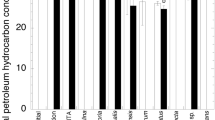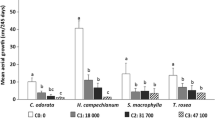Abstract
This work aimed at investigating both the tolerance and the phytodegradation potential of Erythrina crista-galli L. in petroleum-contaminated soil. It consisted in analyzing E. crista-galli germination, surviving, growth, and development when cultivated at different contaminant concentrations and pollutant degradation rates. This specimen was selected because it presented a special behavior among others also exposed to petroleum in an accident that occurred in the Araucaria region (south of Brazil), resulting in a four-million-liter oil spill. The experiment was carried out in a greenhouse containing non-contaminated soil (NCS), vegetated contaminated soil (VCS), and non-vegetated contaminated soil (NVCS) at the following petroleum concentrations: 25 g kg−1 (VCS-25), 50 g kg−1 (VCS-50), and 75 g kg−1 (VCS-75). After 60 days, the soil samples were analyzed by gas chromatography. Germination was more and more evident as higher petroleum concentrations were observed. The surviving rates of groups NCS, VCS-25, VCS-50, and VCS-75 were 64%, 70%, 61%, and 96%, respectively. The VCS group growth was reduced when compared to the control group (NCS). The individuals exposed to petroleum pollution presented differences in the anatomic structure of their roots when compared to the NCS group. It was observed that the petroleum degradation rate was higher for VCS group than for NVCS. E. crista-galli is potentially recommended for petroleum-contaminated soils because of its positive association in the presence of contamination.





Similar content being viewed by others
References
Cunningham, S. D., & Ow, D. W. (1996). Plant Physiology, 110, 715–719.
Maranho, L. T, Azevedo, J. A. M., Preusseler, K. H., & Filho, M. A. S. (2006). Environmental biotechnology and engineering. Proceedings of the Second International Meeting on Environmental Biotechnology End Engineering (2IMEBE). México City. México.
Ferrera-Cerrato, R., Lópes-Ortiz, C., Alarcón, A., Delgadillo-Mártinez, J., Trejo-Aguilar, D., Mendoza-López, R., et al. (2006). Environmental biotechnology and engineering. Proceedings of the Second International Meeting on Environmental Biotechnology End Engineering (2IMEBE). México City. México.
Merkl, N., Schultze-Kraft, R., & Infante, C. (2005). Environmental Pollution, 138, 86–91.
Cunningham, S. D., Anderson, T. A., & Schwab, A. P. (1996). Advances in Agronomy, 56, 55–114.
Pires, F. R., Souza, C. M., Silva, A. A., Procópio, S. O., & Ferreira, L. R. (2003). Revista Planta Daninha, 21(2), 335–341.
Perkovich, B. S., Anderson, T. A., & Coats, J. R. (1996). Pesticide Science, 46, 391–396.
Michel, J., Henry, C. B. Jr., & Thumm, S. (2002). Spill Science & Technology Bulletin, 7, 155–161.
Sangabriel, W., Ferrera-Cerrato, R., Trejo-Aguilar, D., Mendonza-López, M. R., Cruz-Sánches, J. S., López-Ortiz, C., et al. (2006). Internacional de Contaminación Ambiental, 22, 63–73.
Pezeshki, S. R., Hester, M. W., Lin, Q., & Nyman, J. A. (2000). Environmental Pollution, 108, 129–139.
Tischer, R., & Hübner, T. (2002). International Journal of Phytoremediation, 4, 197–203.
Aprill, W., & Sims, R. C. (1990). Chemosphere, 20, 253–265.
Qiu, X., Leland, T. W., Shah, S. I., Sorensen, D. L., & Kendall, E. W. (1997). Phytoremediation of Soil and Water Contaminants, 664, 186–199.
Gunther, T., Dornberger, U., & Fritsche, W. (1996). Chemosphere, 3, 3, 203–215.
Reilley, K. A., Banks, M. K., & Schwab, A. P. (1996). Journal of Environmental Quality, 25, 212–219.
Brandt, R., Merk, N., Schultze-Kraft, R., Infante, C., & Broll, G. (2006). International Journal of Phytoremediation, 8, 273–284.
Hernández-Acosta, E., Ferrera-Cerrato, R., & Rodríguez, R. V. (2003). Terra, 21, 81–89.
Ministério da Agricultura. (1992). Brasil. Regras para análise de sementes.
Johansen, D. A. (1940). Plant microtechnique. New York: McGraw Hill Book.
Berlyn, G. P., & Miksche, J. P. (1976). Botanical microtechnique and cytochemistry. Iowa: Iowa University.
Felder, N., & O’brien, T. P. (1968). American Journal of Botany, 55, 123–142.
Sakai, W. S. (1973). Stain Technology, 48, 247–249.
Schwab, A. P., Su, J., Wetzel, S., Pekerak, S., & Banks, M. K. (1999). Environmental Science & Technology, 33, 1940–1945.
Kuhn, W., Ganbino, R., Al-Awadhi, N., Balba, M. T., & Dragun, J. (1998). Journal of Soil Contamination, 7, 801–806.
Rivera-Cruz, M. C., Trujillo-Nárcia, A., Cruz, M. A. M., & Chávez, E. M. (2005). Interciencia, 30, 326–331.
Maranho, L. T., Galvão, F., Preussler, K. H., Muniz, G. I. B., & Kuniyoshi, Y. S. (2006). Acta Botanica Brasilica, 20, 615–624.
Udo, E. J., & Feyemi, A. A. A. (2001). Journal of Environmental Quality, 4, 537–540.
Hou, F. S. L., Leung, D. W. M., Milke, M. W., & Macpherson, D. J. (1999). Environmental Technology, 20, 413–418.
Siddiqui, S., & Adams, W. A. (2002). Environmental Toxicology, 17, 49–62.
Salanitro, J., Dorn, P., Hueseman, M., Moore, K., Rhodes, I., Rice, L., et al. (1997). Environmental Science & Technology, 31, 1769–1776.
Rivera-Cruz, M. C., & Trujillo-Nárcia, A. (2004). Interciencia, 29, 369–376.
Teal, J. M., & Kanwisher, J. W. (1966). Journal of Experimental Botany, 17, 355–361.
Luxmoore, R. J., Stolzy, L. H., & Letey, J. (1970). Agronomy Journal, 62, 317–322.
Smith, W. H. (1990). In A. A. Lucier & S. H Haines (Eds.), Mechanisms of forest response to acidic deposition (pp. 188–241). New York: Springer.
Merkl, N., Schultze-Kraft, R., & Infante, C. (2005). Water, Air, and Soil Pollution, 165, 195–209.
Merkl, N., Schultze-Kraft, R., & Infante, C. (2004). Bioremediation Journal, 8, 177–184.
Schnoor, J. L., Licht, L. A., Mccutcheon, S. C., Wolfe, N. L., & Carreira, L. H. (1995). Environmental Science & Technology, 29, 318–323.
Reilley, K. A., Banks, M. K., & Schwab, A. P. (1996). Journal of Environmental Quality, 25, 212–219.
Liste, H. H., & Alexander, M. (2000). Chemosphere, 40, 11–14.
Olson, P. E., Reardon, K. F., & Pilon-Smits, E. A. H. (2003). In S. C. McCutcheon & J. L. Schnoor (Eds.), Phytoremediation: transformation and control of contaminants (pp. 317–354). New York: Wiley.
Spriggs, T., Banks, M. K., & Schwab, P. (2005). Journal of Environmental Quality, 34, 1755–1762.
Gudin, C., & Syratt, W. J. (1975). Environmental Pollution, 8, 107–112.
Pivetz, B. E. (2001). Phytoremediation of contaminated soil and ground water at hazardous waste sites. EPA Ground water issue (EPA/540/S-01/500).
Trapp, S., & Karlson, U. (2001). Journal of Soils and Sediments, 1, 1–7.
Singh, O. V., & Jain, R. K. (2003). Applied Microbiology and Biotechnology, 63, 128–135.
Olson, P. E., & Fletcher, J. S. (2000). Environmental Science and Pollution Research International, 7, 195–204.
Mackey, C. V., & DePuit, E. J. (1985). Reclamation & Revegetation Research, 4, 1–16.
Rowell, M. J., & Florence, L. Z. (1993). Soil Biology & Biochemistry, 25, 1499–1511.
Baker, J. M. (1979). In R. L. Jeffries & A. J. Davy (Eds.), Ecological processes in coastal environments (pp. 529–542). London: Blackwell Scientific.
Pilon-Smits, E. (2005). Annual Review of Plant Biology, 56, 15–39.
Author information
Authors and Affiliations
Corresponding author
Rights and permissions
About this article
Cite this article
de Farias, V., Maranho, L.T., de Vasconcelos, E.C. et al. Phytodegradation Potential of Erythrina crista-galli L., Fabaceae, in Petroleum-Contaminated Soil. Appl Biochem Biotechnol 157, 10–22 (2009). https://doi.org/10.1007/s12010-009-8531-1
Received:
Accepted:
Published:
Issue Date:
DOI: https://doi.org/10.1007/s12010-009-8531-1




